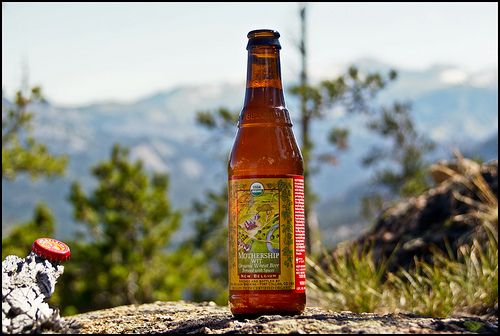
Beer is an ancient beverage with roots growing as far back as the fifth millennia BC. Since malts and hops and barley were first brewed together, the recipe for this popular beverage has endured some drastic changes. Once a highly prized commodity, beer is now a ubiquitous beverage enjoyed in nearly every part of the world. It seems as though, in the United States at least, the evolution of beer has come full circle. From small breweries to mass production and back again, more and more people around the country are brewing beer more artfully – and more sustainably – than ever before.
I’ve heard my dad tell me at least a dozen times that when he was growing up, the beer selection was dismal. As a college student, he had three different beers to choose from, and they were all watery, mass produced and flavorless.
Today, however, we’re seeing a resurgence of craft beers as brewers meticulously concoct new flavors and textures, sometimes reminiscent of the brews from our ancient past.
This renaissance also means that local brewers, with acute attention to detail and community-orientated businesses, ensure quality products while maintaining a low carbon footprint and simultaneously supporting other local businesses and organizations.
According to the Brewer’s Association, the key to craft beer is innovation: interpreting historical recipes in new ways, combining traditional ingredients with new elements to create entirely fresh tastes. In addition, craft brewers tend to be well in-tune with their local communities, actively participating in philanthropy, volunteerism and sponsorship of local events. Unlike their big brothers, craft brewers also tend to be focused on sustainability, using local resources when possible, and maintaining a level of integrity and independence when it comes to their art. More practically, a microbrewery is one that produces less than 6 million barrels a year and cannot be more than 24 percent owned by another beverage company (for example, Anheuser-Busch InBev or MillerCoors).
Part of the Community
Craft breweries tend to start out small, and they are no doubt central fixtures in small towns and cities all over the country. Not only do most craft breweries buy local or regional ingredients, but they also more responsibly dispose of their waste and support community projects and businesses while boosting morale.
“Community is extremely important to us, as it should be for any local business, no matter how big or small,” states Geoff Wenzel, head brewer at Keegan Ales, a craft brewery in Kingston N.Y. “I’ve lived in Kingston my whole life, and we want to bring the right type of people to our community, people who want to make this a better place.”

Many microbreweries purchase the majority – if not all – of their ingredients from local farmers or other small businesses. Some grow their own hops, and others purchase malt from local, small-scale maltsters (the clever name for people who create the malts used in brewing). Buying from local manufacturers can also help regulate the prices and markets for small farmers, bolstering their businesses.
In addition to supporting local development efforts, many microbreweries take an active role in charitable events. Breweries such as Full Sail purposefully try to create a culture that attracts socially and environmentally conscious employees. The company acts as an advisor for local organizations and businesses who want to “go green” and sponsor more than 300 local charities and events each year. Kona Brewing Company in Hawaii organizes the Kona Brewers Festival, which has raised more than $350,000 for local organizations such as the Sierra Club, Surfrider, the Kokua Festival, and other cultural and environmental groups. New Belgium Brewing Company, also employee owned, sponsors numerous community- and bicycle-oriented events each year, including the increasingly popular Tour de Fat, and encourage their employees to donate hours of volunteer time to local charities.
Protecting the Environment
Community values are not limited to volunteerism and charitable contributions. Helping local organizations often spills over into the environmental realm, and microbreweries often find themselves at the forefront of conservation efforts and discussions, for example about fracking.
“I can rant on for days about why fracking is one of the most ridiculous energy plans I’ve ever heard of,” says Wenzel of Keegan Ales. “People do not realize how important water is.”
For a company that depends on local freshwater to create its product, contamination can have dramatic effects. Much like Scotch and other alcoholic beverages, the quality of water – and the vitamins and minerals therein – can dramatically change the taste of the final product. This means that the conservation of such natural resources becomes a hot issue for many microbreweries.

Keegan Ales, like many other craft breweries, dispose of their waste in a sustainable way that affects both the community and the Earth at large. “Most of our solid waste (spent grains) goes to farmers to feed local cattle and pigs.” This practice is extremely beneficial to local farmers especially as livestock feed prices are on the rise. In many cases, brewpubs will then purchase beef and pork from these local farms, creating a sustainable beer-to-farm-to-table circle. At Kona Brewing, spent grains not sent to local farms are used in the brewpubs’ pizzas and breads.
In utilizing local waste treatment facilities, Keegan Ales helps these facilities to more easily turn down unsavory potential businesses that wish to employ unsustainable practices.
“We are lucky that our city has a waste treatment facility that can completely handle any amount of waste that we would produce in the foreseeable future,” says Wenzel. “They were even approached by certain companies that want to hydrofrack to dispose of their waste because their system could handle it. They denied this company’s request.”
Like any manufacturing company, breweries need energy to create a quality product. But unlike their big beverage brothers, microbreweries take active steps to minimize the carbon footprint of their brews.
Sierra Nevada Brewing Company houses one of the largest, privately-owned solar arrays in the country, an array that provides 20 percent of the company’s energy needs. Another 40 percent is provided by hydrogen fuel cells that use non-combustion technology. In addition, while most of their products are shipped via rail (50 percent cleaner than road travel), their small fleet of trucks are largely powered by waste vegetable oil from their restaurant.
New Belgium also supplements its energy needs with solar power, but they are really famous for being the first brewery in the United States to receive what was then 100 percent of its electricity from wind power. Their turbine farm is located in Medicine Bow, WY, and tied directly to their power grid.
Of course, brewing craft beer requires more than just electricity: often, it calls for more skill and more people power, than is needed in the larger brewery companies. There is less of a reliance on machines, which use large amounts of energy, and more of a reliance on individuals. Brewers don’t merely supervise the processing, but they learn and teach a skill. Breweries are therefore more autonomous, and their workers are more empowered. Wenzel initially started by helping out around the brewery after high school graduation doing things like maintenance. Ten years later, he is the head brewer. Often, microbreweries are employee-owned or offer shares of the business to employees as a benefit.
Large breweries, on the other hand, are disconnected from their product as well as the people that consume them. The two largest beer companies in the world, InBev and SABMiller, now own more than 200 brands all over the world, monopolize the brewing industry while remaining disconnected from their base. Craft breweries not only require skill to produce a delicious brew but they also require community engagement, which usually results in a sense of connection to their product.
These sustainable craft breweries need consumer support, however, for as they begin to gain traction, Anheuser-Busch InBev and SABMiller are starting to feel threatened. These larger brewery products are becoming less visible on store shelves and sales are dwindling. In response, they are trying hard to thwart craft beer consumption by creating their own “faux” craft brews.
Do your taste buds, community and the environment a favor and support a local brewery!
Photo courtesy of Jonmikel Pardo